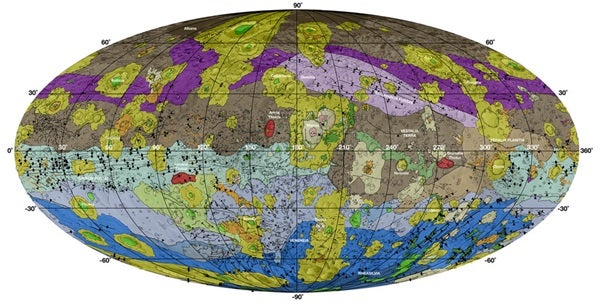Geological mapping is a technique used to derive the geologic history of a planetary object from detailed analysis of surface morphology, topography, color, and brightness information. Mapping the surface of Vesta using Dawn spacecraft data was a team of 14 scientists led by three NASA-funded participating scientists: David A. Williams of Arizona State University, Tempe; R. Aileen Yingst of the Planetary Science Institute in Tucson, Arizona; and W. Brent Garry of the NASA Goddard Space Flight Center in Greenbelt, Maryland.
“The geologic mapping campaign at Vesta took about two-and-a-half years to complete, and the resulting maps enabled us to recognize a geologic timescale of Vesta for comparison to other planets,” said Williams.
Scientists discovered through these maps that impacts from several large meteorites have shaped Vesta’s history. Asteroids like Vesta are remnants of the formation of the solar system, giving scientists a peek at its history. Asteroids also could harbor molecules that are the building blocks of life and reveal clues about the origins of life on Earth.
The geologic mapping of Vesta is enabled by images obtained by the framing camera provided by the Max Planck Institute for Solar System Research of the German Max Planck Society and the German Aerospace Center. This camera takes panchromatic images and seven bands of color-filtered images. Stereo photos are used to create topographic models of the surface that aid in the geologic interpretation.
Vesta’s geologic timescale is determined by the sequence of large impact events, primarily by the Veneneia and Rheasilvia impacts in Vesta’s early history and the Marcia impact in its late history. The oldest crust on Vesta predates the Veneneia impact. The relative timescale is supplemented by model-based absolute ages from two different approaches that apply crater statistics to date the surface.
“This mapping was crucial for getting a better understanding of Vesta’s geological history, as well as providing context for the compositional information that we received from other instruments on the spacecraft: the visible and infrared (VIR) mapping spectrometer and the gamma-ray and neutron detector (GRaND),” said Carol Raymond from NASA’s Jet Propulsion Laboratory in Pasadena, California.










